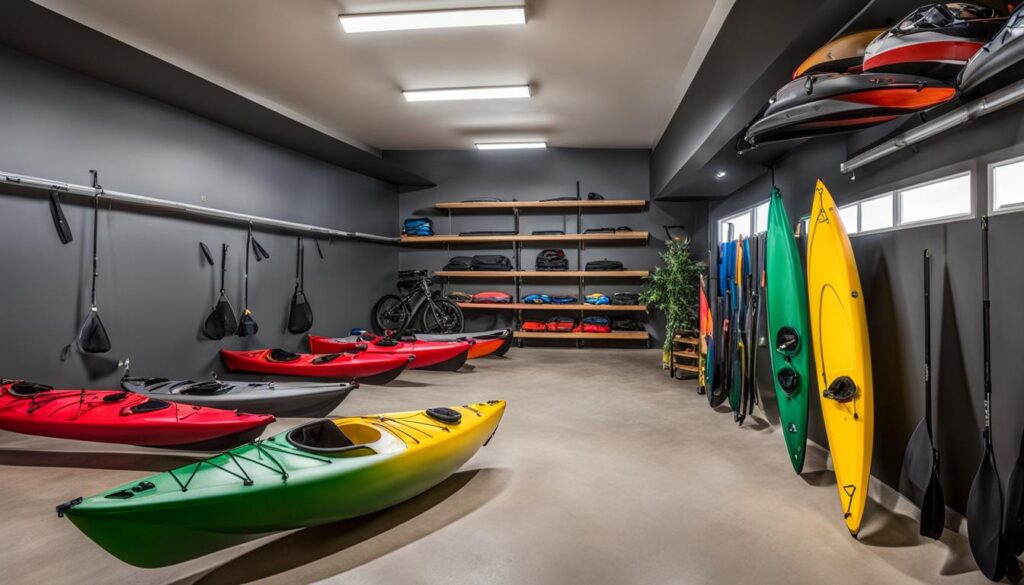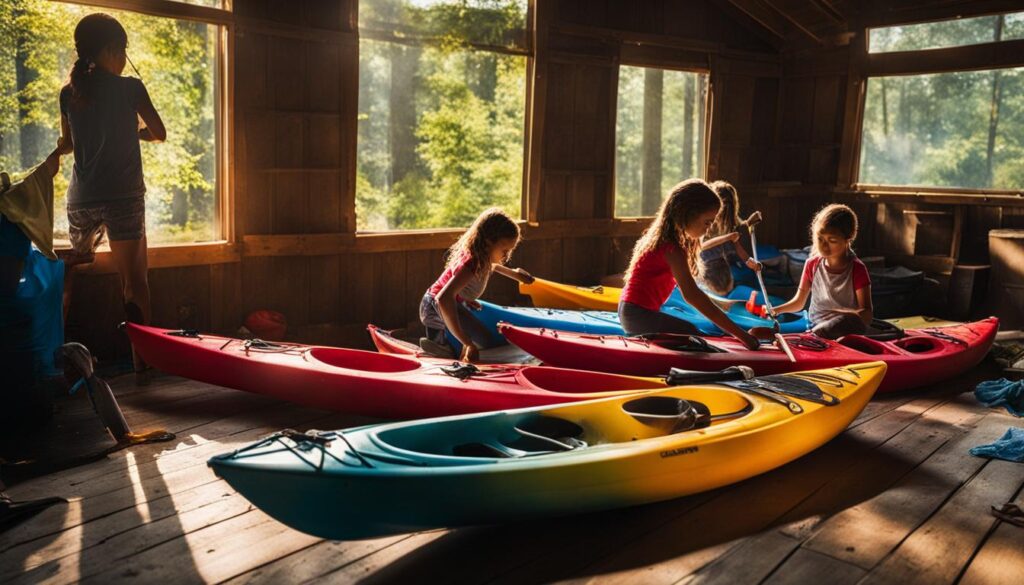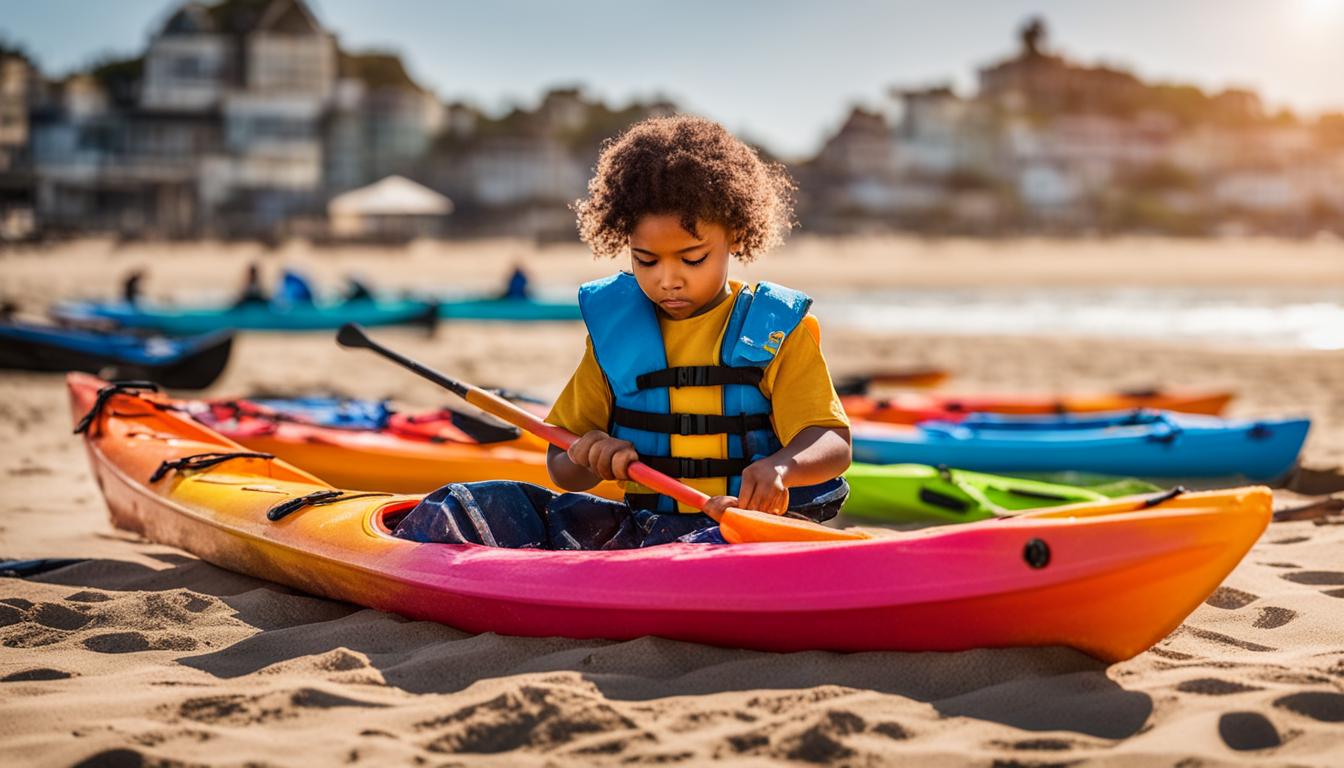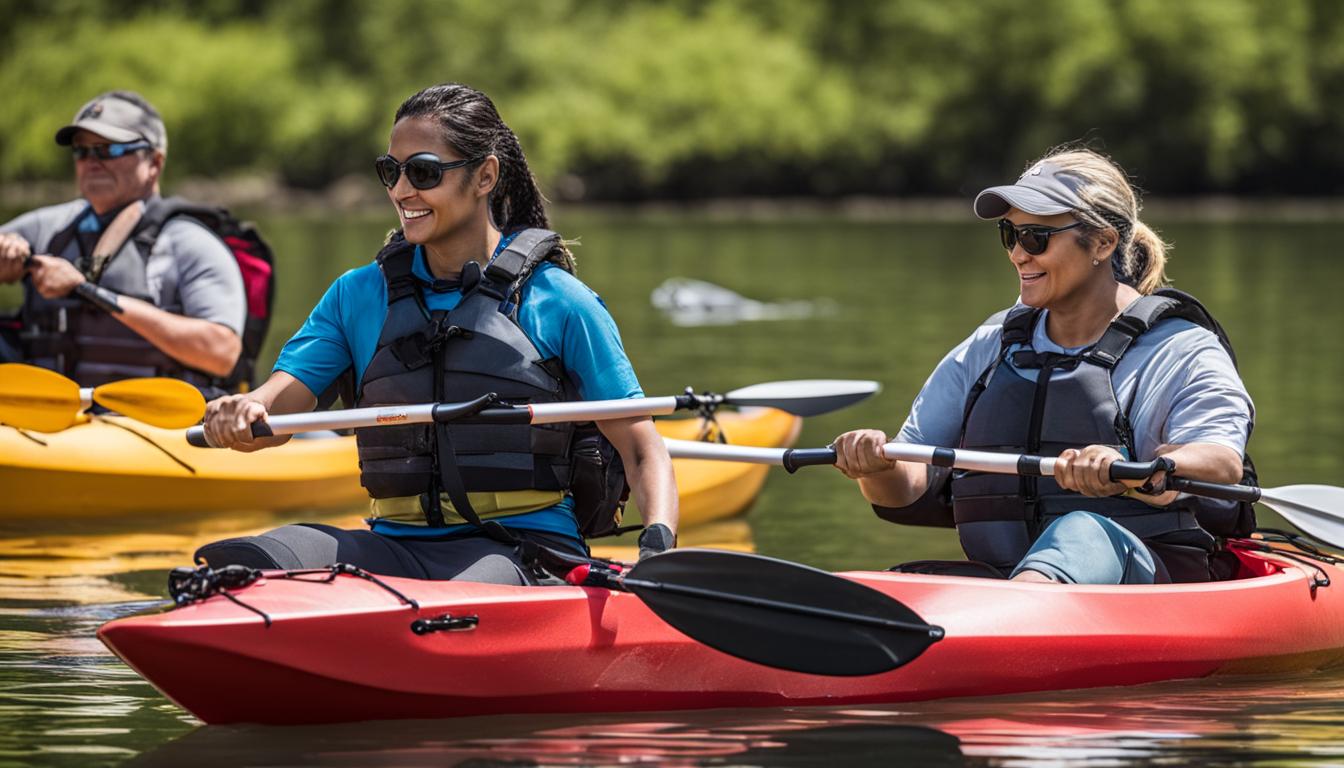Taking care of a kayak is essential to ensure its longevity and optimal performance. This guide will provide you with simple steps to teach kids how to maintain and care for their kayaks. By instilling these skills early on, children can develop a sense of responsibility and pride in taking care of their equipment.
Key Takeaways:
- Teaching children kayak upkeep and maintenance instills responsibility and pride in caring for their equipment.
- Proper pre-storage care includes cleaning both the inside and outside of the kayak, drying it thoroughly, and inspecting for any damage.
- Indoor storage is ideal to protect kayaks from the elements, while outdoor storage requires additional precautions to prevent damage.
- Proper kayak storage techniques, such as using well-padded brackets or slings, ensure the longevity of the equipment.
- Kids should also learn to take care of their paddles and other gear by rinsing, cleaning, and applying protective measures.
Pre-Storage Care for Kayaks
Proper pre-storage care is crucial to keep kayaks in good condition during the off-season. Kids should learn to clean both the inside and outside of the kayak with water and light soap to remove dirt and grime. It’s important to dry the kayak thoroughly before storing it to prevent water damage. They should also rinse and store the kayak’s accessories, tighten any screws or bolts, and check for any hull or deck damage. Additionally, kids should oil any metal parts and consider applying a sun-protective spray to hard-shell kayaks. Teaching children these basic kayak repair techniques and storage practices can help them develop good maintenance habits.
When it comes to pre-storage care for kayaks, there are a few key steps to ensure the longevity and performance of the equipment. Here’s a breakdown of the tasks that kids should learn:
- Cleaning: Use water and light soap to thoroughly clean the inside and outside of the kayak, removing any dirt, grime, or salt residue.
- Drying: After cleaning, make sure to dry the kayak completely before storage. This helps prevent any moisture-related damage.
- Accessories: Rinse and store any accessories that were used with the kayak, such as paddles, spray skirts, or drybags.
- Inspection: Check for any signs of damage to the hull or deck, such as cracks or leaks. Tighten any loose screws or bolts.
- Maintenance: Apply oil to any metal parts, such as hinges or rudder systems, to prevent rust. Consider using a sun-protective spray on hard-shell kayaks to shield them from UV damage.
By teaching children these basic pre-storage care techniques, they can develop responsible habits that will keep their kayaks in great shape for years to come.
| Step | Description |
|---|---|
| Cleaning | Use water and light soap to clean the kayak inside and outside, removing dirt, grime, and salt residue. |
| Drying | Thoroughly dry the kayak to prevent moisture-related damage. |
| Accessories | Rinse and store any kayak accessories, such as paddles, spray skirts, or drybags, that were used. |
| Inspection | Check for hull or deck damage, including cracks or leaks. Tighten any loose screws or bolts. |
| Maintenance | Apply oil to metal parts and consider using a sun-protective spray on hard-shell kayaks. |
Indoor Kayak Storage
When it comes to storing kayaks, keeping them indoors is the best option to ensure their longevity and prevent damage from the elements. Teaching children the importance of storing their kayaks indoors can help them understand the value of proper preservation and care.
Here are some key tips for indoor kayak storage:
- Choose a storage location away from windows to prevent damage from sunlight and moisture.
- Keep the kayak away from heat sources to avoid excessive heat damage.
By following these simple steps, kids can help maintain the condition of their kayaks and ensure they are ready for their next paddling adventure.
“Storing kayaks indoors is the best way to protect them from the elements and ensure their longevity.”

Tips for Indoor Kayak Storage
| Storage Tip | Description |
|---|---|
| Choose a suitable location | Select a garage, shed, or spare room in your home to store the kayak. |
| Avoid direct sunlight | Position the kayak away from windows or cover it with a tarp to prevent damage from UV rays. |
| Maintain temperature control | Keep the kayak in an area with stable temperature to prevent heat or cold damage. |
| Use proper supports | Store the kayak on padded brackets or slings made of nylon webbing straps to provide optimal support. |
Kids’ Responsibilities in Kayak Care: Outdoor Kayak Storage
When it comes to storing kayaks outdoors, kids can take on important responsibilities to ensure the proper care of their equipment. By following these children’s kayak storage advice, they can protect their kayaks from the elements and minimize the risk of damage.
Proper Location
Choosing the right location is crucial for outdoor kayak storage. Kids should find a shaded area away from direct sunlight to prevent UV damage. Additionally, the storage spot should be free from excess moisture, sand, dust, bugs, and animals. It’s also important to consider theft protection by keeping the kayak hidden from view and using a security cable to secure it to a post or building.
Weather Protection
Weather-resistant tarps or kayak covers can provide an extra layer of protection for outdoor kayak storage. When using a tarp, it should be positioned like a tent to allow rain or snow to slide off. This prevents water from accumulating and potentially damaging the kayak. By investing in proper weather protection, kids can ensure the longevity of their kayaks.
Proper Storage Techniques
Teaching children the proper storage techniques is essential for maintaining the structural integrity of their kayaks. Using well-padded rigid brackets or slings made of nylon webbing straps provides optimal support. It’s important to align the brackets or slings with the kayak’s bulkheads to evenly distribute the weight. Depending on the manufacturer’s recommendations, the kayak can be stored right-side-up, inverted, or on its side.
By following these outdoor kayak storage practices, kids can develop a sense of responsibility and pride in taking care of their equipment. Proper location, weather protection, and storage techniques will ensure the longevity of their kayaks and enhance their overall kayaking experience.
Proper Kayak Storage Techniques
Teaching children the importance of proper kayak storage techniques is essential for maintaining the longevity of their equipment. By following these guidelines, kids can ensure their kayaks remain in excellent condition for years to come.
Storing the Kayak
When it comes to storing a kayak, it’s crucial to provide adequate support to prevent warping or damage. One recommended method is using well-padded rigid brackets or slings made of 2- to 3-inch-wide nylon webbing straps. These supports should be aligned with the kayak’s bulkheads to offer optimal stability.
Choosing the Right Position
Depending on the manufacturer’s recommendations, kayaks can be stored right-side-up, inverted, or on their side. It’s important to follow their guidelines to maintain the kayak’s structural integrity. Different kayak models may have varying requirements, so it’s essential to refer to the manufacturer’s instructions for the correct storage position.
Taking Additional Precautions
In addition to properly supporting the kayak, there are a few more steps that can be taken to ensure its safety during storage. These include:
- Securing the kayak in a dry, clean, and well-ventilated area to prevent moisture damage
- Keeping the kayak away from heat sources to avoid warping or deformation
- Covering the kayak with a weather-resistant tarp or kayak cover to protect it from dust, debris, and UV rays
- Regularly inspecting the kayak for any signs of damage or wear
By teaching children these proper kayak storage techniques, they will develop good maintenance habits and ensure their kayaks are always ready for their next adventure.

Kayak Paddle and Gear Maintenance for Young Paddlers
Proper maintenance of your kayak extends beyond just taking care of the kayak itself. It’s important to teach young paddlers how to properly maintain their paddles and other gear to ensure optimal performance and longevity. By instilling these maintenance skills early on, children can develop a sense of responsibility and pride in taking care of their equipment.
The Paddle: Rinse, Lubricate, and Protect
After each kayaking session, kids should rinse their paddles with fresh water, paying special attention to the metal parts. This helps remove salt, sand, and other debris that can cause damage over time. Additionally, it’s a good practice to apply a dry lubricant or wash the ferrules with mild detergent to prevent corrosion and ensure smooth operation.
Remember, a well-maintained paddle provides better control and efficiency in the water, enhancing the overall paddling experience.
Other Gear: Cleaning and Protection
In addition to the paddle, it’s important to teach kids how to clean and protect their other gear. Gear such as personal flotation devices (PFDs), spray skirts, wetsuits, and dry bags should be washed with mild detergent to remove dirt, salt, and other contaminants. Proper cleaning helps maintain their functionality and extends their lifespan.
Applying a 303 UV protectant to these gear items can also help prevent sun damage, ensuring they remain durable and effective over time. This is especially important for items that are frequently exposed to sunlight.
Teaching Responsibility and Care
By teaching children how to properly maintain their paddles and gear, they develop important skills in responsibility and care. These skills not only benefit their equipment’s lifespan but also foster a greater appreciation for the sport of kayaking.
By ensuring that young paddlers understand the value of regular cleaning, lubrication, and protection, they will be better equipped to enjoy their kayaking adventures with gear that is in optimal condition.
| Paddle Maintenance | Other Gear Maintenance |
|---|---|
| Rinse paddle with fresh water after each use | Wash PFDs, spray skirts, wetsuits, and dry bags with mild detergent |
| Pay attention to metal parts and remove debris | Apply 303 UV protectant to prevent sun damage |
| Apply dry lubricant or wash ferrules with mild detergent |
With these maintenance practices in place, young paddlers can confidently explore the waterways, knowing that their equipment is well cared for and ready for their next adventure.
Conclusion
By teaching kids proper kayak maintenance and care, you are not only ensuring the longevity of their equipment but also instilling important skills and responsibilities in them. Regular cleaning, thorough drying, and proper storage techniques are key to prolonging the lifespan of their kayaks. Additionally, taking care of their paddles and other gear will ensure optimal performance and safety during their kayaking adventures.
Remember to create a young kayaker’s maintenance checklist to help your child stay organized and accountable for their kayak care. This checklist can include tasks such as rinsing the kayak after each use, checking for any damage, tightening screws or bolts, and storing the kayak in a safe and suitable location. In addition, don’t forget to include paddle and gear maintenance tasks like rinsing the paddle with fresh water and applying a dry lubricant to the ferrules.
By incorporating these habits early on, your child will develop a sense of responsibility and pride in taking care of their equipment. Not only will they enjoy their kayaking adventures more, but they will also learn the value of responsible maintenance. So, start teaching them these important skills today, and watch them become confident and responsible young kayakers!
FAQ
Why is kayak maintenance important for kids?
Teaching kids how to maintain and care for their kayaks instills a sense of responsibility and pride. It also ensures the longevity and optimal performance of their equipment.
What pre-storage care steps should kids take for their kayaks?
Kids should clean both the inside and outside of the kayak with water and light soap, dry it thoroughly, rinse and store accessories, tighten screws or bolts, check for damage, and oil metal parts. They can also consider applying a sun-protective spray to hard-shell kayaks.
Where should kids store their kayaks during the off-season?
Storing kayaks indoors, in a garage, shed, or spare room, is the best option to protect them from the elements. If indoor storage is not possible, they can store them outdoors in shaded areas with proper protection from moisture, UV rays, and other elements.
How should kids store their kayaks indoors?
Kids should store their kayaks on well-padded rigid brackets or suspended in slings made of nylon webbing straps. The kayak can be stored right-side-up, inverted, or on its side, depending on the manufacturer’s recommendations.
How should kids store their kayaks outdoors?
Kids should store their kayaks outdoors in shaded areas, protecting them from moisture, UV rays, sand, dust, bugs, and animals. Weather-resistant tarps or kayak covers can provide extra protection.
How should kids take care of their paddles and other gear?
Kids should rinse their paddles with fresh water after each use, paying attention to metal parts, and apply a dry lubricant or wash the ferrules with mild detergent. Other gear such as PFDs, spray skirts, wetsuits, and drybags should be washed with mild detergent and have 303 UV protectant applied to prevent sun damage.





